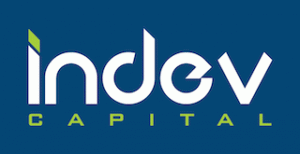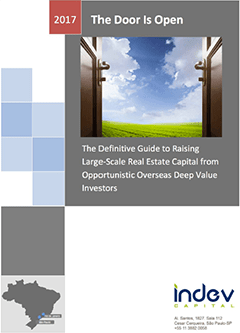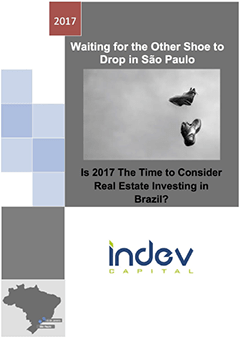
If one talks to a person in the community of Duplin County, North Carolina and asks for his or her image of Brazil, if this person has an image of Brazil at all, it will include an image of the sun, perhaps the beach, and perhaps soccer with an image of Pelé, depending on the person’s age. If this image of sunny Brazil resonates in Duplin County, North Carolina, why is this not the case for Global Opportunistic Investors that have offices in Midtown Manhattan, Boston, London and other locations where global alternative asset managers reside?
Solar Energy Investments in Brazil – An Opportunistic Perspective
Purpose of This Newsletter 
For better or for worse, this newsletter has nothing to do with Duplin County, North Carolina. However, it does have a lot to do with opportunistic investing in Emerging Markets. InDev Capital, the publisher of this newsletter, is a Real Asset Emerging Market Merchant Bank. Our mission and reason to exist is to provide clarity to Global Opportunistic Investors such that unobvious large-scale high risk-adjusted return investment opportunities become obvious large-scale investment and profit opportunities. Importantly, our firm has a track record in this effort. Please see a recent case study with a 40% plus IRR and large-scale project-level profits on an investment of over US$100M+.
If you are not a resident of Duplin County, which has a very low cost of living by the way, but are a global opportunistic investor or someone who has such an interest and mindset, let’s take a journey to understand how the sun in Brazil can provide a 20%+ IRR in local currency or high teens IRR in US dollars. For those who want to dig in deeply, please click here for a comprehensive white paper on opportunistic investing in solar energy in Brazil.
Brazil: An Opportunistic Investor’s Paradise or Hell?
The answer is both! 
As you can tell from the introduction, my roots are not in Brazil. Although all three of my kids were born in Brazil, I met my wife there, and I spent 10 years of my life in Sao Paulo, when it comes to my money, and hopefully yours, I am a realist about Brazil. Let’s be clear, emerging markets are emerging markets for a reason. The moment someone tries to offer a USD investor “core” returns or non-opportunistic investments in emerging markets, in my humble opinion either hold your wallet, run away as if you had seen a madman, or both quickly. However, for global investors on the more opportunistic side of the table, emerging markets, and Brazil in particular at this specific time in the cycle, warrant serious consideration. Why?
Opportunistic Investing 101 – A Quick Brazil Summary

Scale
Emerging markets are difficult to understand, have their own particular risk dynamics, and often, as stated much more eloquently by Eurasia’s Ian Bremmer, their politics can have just as much if not more impact than the market outcomes for many investment situations. That being said, when an investor has the right mindset, understanding, and particularly awareness of where a country is in its cycle, the profit opportunities can be significant. However, and this is important, because of the brain damage involved in investment in emerging markets, it is important that the opportunity have scale. With a population of 210 million people, GDP of USD 1.8 trillion, multiple business centers, and multiple cities with populations of over 1 million people, Brazil offers real asset investors core demand combined with the scale of profits. InDev defines scale as investment opportunities that can generate at least 20+ million dollars of profit.
Capital Advantage
Due to structural reasons, historically high fixed-income products, and a paucity of savings, Brazil has never quite developed significant large-scale opportunistic capital. Hence, intelligent large-scale capital earns a premium return. There are several reasons for the dearth of large-scale capital in Brazil. Firstly, Brazil is a relatively new democracy and, as such, the political-economic system has created an environment where core interest rates, until very recently, were quite high. This resulted in a strong investor orientation towards domestic government fixed-income products. In most developed markets, pension funds are one of the lead funding sources for alternative asset manager capital. However, Brazil’s largest pools of capital have not developed this institutional knowledge of opportunistic investing. This provides a unique opportunity for Global Opportunistic Investors to pursue large-scale and profitable opportunities in the Brazilian Real Asset Market.
Public – Private Arbitrage
At this time in Brazil’s medium-term, there is a significant public-private arbitrage opportunity. In the private markets, one can develop to a cash-on-cash yield in the double digits, however the same opportunities are trading in the public markets, upon stabilization, at a 300 basis point premium. There is a clear development yield spread in many large-scale public and private markets.
Core Demand
One’s chosen sector must be selected intelligently and carefully. One of the best and most important aspects of emerging market investments is that in some basic investment strategies with obvious and strong demand, where the profit margin has been squeezed in developed markets by an ABUNDANCE of capital, the same opportunities offer high returns in emerging markets due to less available capital and an earlier stage of development.
Emotional Market and the Search for Yield
Structural changes in Brazil have lowered core interest rates at this point in the cycle. This is a significant shift in the general business community, equity and debt capital markets, and the operating environment for investors. This creates a strong desire for investors to trade formerly high-yield government sovereign debt in Brazil for real asset income-producing investments. This represents a significant change in the market, which opens up a unique opportunity for investors, as yield-seeking capital markets create an excellent opportunity for positive outcomes and attractive exits.
Brazil Opportunistic Investments, Why Now?

“Why Now” is a very important question for emerging market opportunistic investors. In candor, there are always more reasons not to invest in emerging markets than there are to invest. So, what drives a why now for an emerging market investment?
Cycle Timing
Emerging markets, in my humble opinion, are more emotional and asset prices tend to move very quickly. Often, that speed is built based on emotion more than relative value. Hence, it is often important to be in the market at times when the chosen asset class is still early in its development, there is clear verifiable demand, and there is not a lot of other capital bidding assets to an extreme price level. For example, three years ago, our firm was very active in the acquisition of logistics assets, during a very opportunistic part of the cycle. There was much less capital chasing these opportunities in Brazil in 2016 (none), 2017 (small), and 2018 (last window). It was a buyer’s market. Currently, it is completely different and is very much a seller’s market, so much so that assets that were almost unsellable in a prior environment are now asking for yields and selling for prices that are, to put it lightly, a stretch.
Cash Flow
Long-term contracts with quality credits that provide solid cash flow are vital for emerging market investments, in most cases. These long-term, minimum 15+ years, contracts provide security in the ability of an investor to source an exit opportunity. There are unique investment opportunities that can create value without long-term contracts, for example Urban Infill Logistics, which is an area that InDev believes is an exception. However, in most cases, it serves investors well to have 10+ year contracts with quality credits as a core underlying component of an emerging market investment in Brazil.
Multiple Investment Opportunities in the Same Strategy
Naturally, global opportunistic investors are specific investment opportunity-driven. However, through hard-earned experience InDev believes it is important to find an investment strategy that has multiple large-scale opportunities to pursue. We believe this because the first opportunity may not be the right fit as there are often situations that warrant walking away. We have found that often the best value is created by finding a local sponsor (co-investor and on-the-ground operator) and developing a strategy with multiple acquisition or development opportunities. Crucially, the creation of a business relationship such that both parties agree on the investment checklist to pursue transactions is vital. Then, the investor and local sponsor jointly pursue various opportunities that fit the checklist. The wrong way or difficult way to look at emerging markets is on a one-off basis where one is shown a deal and doesn’t have a chance to evaluate the quality of the sponsor who presents the deal nor the necessary time to really dive deep into understanding the investment thesis.
Cost Basis / Development Yield
It is very important that an investor enters a project such that the cost basis and / or the development yield generate an exit spread of 200 plus basis points, with conservative underwriting assumptions. At InDev, we believe this is possible at certain times in the cycle and with certain assets. When this is not possible, we believe investors need to step back, pause, and consider the risk-reward profile of any type of development project or acquisition.
Downside Protection
As Warren Buffett says, job number one of an investor is to not lose money and job number two is to watch job number one. It is critical that principle is protected, hence one must buy either below replacement cost or structure transactions such that downside is minimized.
Capital Structure
Often in Brazil, debt has a variable component. Occasionally, less sophisticated sponsors will enter into transactions and use leverage that is cheap at the time of funding but has a variable component that can change. This is to be avoided at all costs, or at least very carefully analyzed. In contrast, on the buy side, opportunistic investors should be on the lookout for situations where sponsors have variable-cost debt. Often these types of loans can create significant pressure on asset owners in a higher interest rate environment, which creates opportunities for investors.
Why Now for Solar Energy in Brazil?
Or a better question: why is InDev, a niche Boutique Merchant Bank and not a huge firm in Midtown Manhattan or the city of London, willing to put its own earned cash into solar energy in Brazil at this time?
Path to Cash, Exit Viability
The core demand issue is covered. There are long-term contracts with quality credits and a clear development yield spread. In addition, there are clear potential exits via either the capital markets or buyers who use the capital markets, both equity and debt, as a purchaser.
Providing a Product that Local Equity and Debt Capital Markets Desire
Brazil’s low-interest-rate environment creates a situation where there is a strong search for yield at this time in the cycle. Long-term income with inflation protected cash flow stands the test of time in both good and bad situations in Brazil.
Avoidance of Risk
Large-scale capital investors are able to walk into a project after all the initial survey work is completed and, most importantly, the long-term contract with the off-taker is secured under a signed option. The largest risk is off the table.
Core Competency and Structural Advantage of Brazil 
The high level of solar radiation in Brazil is an advantage that few other nations possess. In addition, in Brazil solar energy is generated close to the main demand centers and therefore transmission or energy loss ratios are relatively low, driving high returns.
If you would like to learn more about solar energy in Brazil and why we believe that Global Opportunistic Investors should take a look, please see our white paper by clicking here and find a comprehensive analysis of the investment opportunity. And of course, if you are in a strong need to “get your mind right” and come home to Eastern North Carolina, “Down East”, please reach out to me a couple of months in advance at joseph.williams@indevcapital.com and I will try to go with you!
Thanks So Much for Reading!
Happy Holidays and Happy Investing!




